
Saxifrages: planting, growing and care
Contents
Saxifrages in a nutshell
- Saxifrages are excellent little young plants for rock gardens!
- They bear star-shaped flowers, solitary or gathered in large, fluffy inflorescences.
- Their flowering is quite bright: it can be white, yellow, pink, or red!
- Their leaves, often in rosettes, are very decorative.
- They are small young plants that have a tapetum or cushion habit.
A word from our Expert
Saxifrage is a small hardy plant that often grows in cushions, interesting for both its flowering and its foliage! It is the ideal plant to enhance a rockery or a low wall. It offers star-shaped flowers, sometimes gathered in large, airy inflorescences, as seen in the Painter’s despair, Saxifraga umbrosa. The flowering of saxifrage can be pink, red, purple, white, or (more rarely) yellow. There is also a great diversity in foliage, which is very decorative and often arranged in rosettes close to the ground. Saxifrage can form small, very dense carpets of leaves, as seen in Saxifraga arendsii, the moss saxifrage. The Saxifraga stolonifera, or spider saxifrage, on the other hand, forms large tufts of leaves and can be used as ground cover.
Saxifrage is a very hardy plant, highly resistant and not very susceptible to diseases. It is particularly sensitive to excess moisture. It has the advantage of being quite easy to propagate. Saxifrages are divided between alpine species, which are more suited for rockeries and adapted to dry, well-drained soils, and Asian species, such as Saxifraga fortunei, which are more suitable for woodland gardens, to be planted in humus-bearing, cool soil.
Saxifrages can occupy neglected spaces where other plants do not thrive. They will brighten up an old wall, a dry, shaded area, a crack between rocks, or a gap in paving… They require very little to settle in. They can also be used to add colour to green roofs, alongside houseleeks and sedums.
Botany
Botanical data
- Latin name Saxifraga sp.
- Family Saxifragaceae
- Common name Saxifrage
- Flowering often spring or summer
- Height between 10 and 30 cm
- Exposure very variable. Sun to partial shade for alpine species, shade for Asian species
- Soil type draining, rocky
- Hardiness between -15 and -20 °C
The saxifrages (Saxifraga, in Latin) comprise around 450 species of small herbaceous plants with a tufted, mat-forming or cushion-like habit. They are predominantly mountain plants, growing in the alpine regions of the temperate zones of the Northern Hemisphere. About fifty different species can be found in the wild in France. Many species of saxifrages grow in the Alps. Saxifraga biflora can be found at altitudes of up to 4,000 metres in the Alps. They are sometimes also found in glacial regions and particularly cold areas. Saxifraga nathorstii, for example, grows in eastern Greenland.
Saxifrages are often rupicolous plants: they grow on rocky walls, cliffs, or slip into the cracks between rocks. They have had to adapt to harsh, if not extreme, conditions: cold, wind, large temperature fluctuations between day and night, very little substrate… They are therefore robust plants and generally very hardy! They manage to slip their roots into the cracks between the rocks, making a place for themselves and adapting to their environment. As saxifrages live in difficult conditions and in fairly isolated locations, this has given rise to many endemic species (found only in one place, in a restricted territory).
Saxifrages constitute a large, well-diversified group, with significant variations in forms and habitats (and therefore in cultivation conditions). Thus, besides alpine species, some saxifrages are native to Asia. This is the case for Saxifraga stolonifera, Saxifraga fortunei, and Saxifraga cortusifolia, to name just a few. These plants have very different cultivation conditions from alpine saxifrages: they grow in shade, in woodlands, on cool, humus-bearing soils.
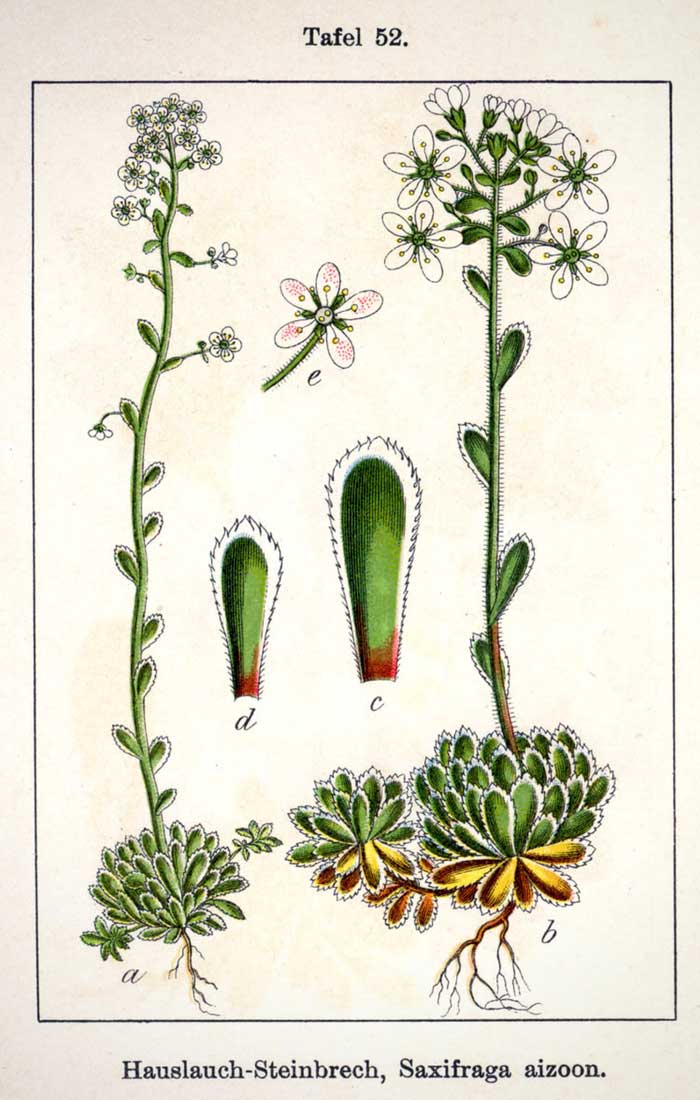
Saxifraga paniculata (= Saxifraga aizoon): botanical illustration
Saxifrages are predominantly perennial plants, although they can sometimes be annual or biennial. Some are semelparous: they flower once, produce seeds, and then die.
Saxifrages represent the largest genus in the Saxifragaceae family, a botanical family that includes nearly 800 species of herbaceous plants native to temperate or cold regions of the Northern Hemisphere. This family also includes astilbes, bergenias, heucheras, and rodgersias.
Their name comes from the Latin Saxum: rock, large stone, and frangere: to break. They are sometimes referred to as “stone-breakers” or “stone-piercers.” Two different explanations are possible for these names: it either comes from the fact that they grow in the cracks between rocks (according to Abbé Coste), or from their medicinal properties for treating kidney stones (according to Fournier).
Saxifrages are small mat-forming or cushion-like plants that can be very dense. Their rosettes can slip between stones, in rock crevices. At other times, they spread out, embracing the shape of the stones. Most of the time, they measure between 10 and 30 cm high. Some species, such as Saxifraga stolonifera, can be used as ground cover. Saxifrages have a slow growth rate, but once established, they generally have a long lifespan.
Alpine saxifrages often take on a compact cushion habit, consisting of small leaves, while Asian species form tufts of much larger leaves.
The majority of saxifrages are evergreen, and are therefore decorative even in winter! However, Saxifraga fortunei and Saxifraga cortusifolia are deciduous to semi-evergreen: the leaves remain in place in a mild climate but disappear if the winter is cold!
The shape of saxifrage leaves is quite varied. Most of the time, they are simple and small, with a lamina that is often crenate or dentate. They are often thick, somewhat fleshy, or even succulent. The Latin name of the species sometimes indicates the shape of the leaves: Saxifraga rotundifolia has round, nicely dentate leaves; Saxifraga longifolia bears elongated leaves; while the leaves of Saxifraga tridactylites (“three-fingered saxifrage”) are divided into three sections! Asian species generally have more developed foliage than alpine ones. Thus, Saxifraga fortunei has fairly large leaves, reminiscent of heuchera foliage.
Most of the time, the leaves are arranged in a rosette, and are located very close to the ground. They can be imbricate in a way that forms a spiralled shape, as seen in the stunning Saxifraga florulenta! Sometimes, when the leaves are small and densely gathered, the saxifrage resembles a small carpet of moss, as in Saxifrage arendsii, which is why it is nicknamed Moss Saxifrage!
In most species, the leaves are green. Some saxifrages have a beautiful silvery hue, such as Saxifraga cochlearis. The Saxifraga cortusifolia ‘Black Ruby’ has very dark, chocolate-coloured leaves, almost black, while those of the Saxifraga umbrosa ‘Variegata’ are variegated with yellow. Saxifraga fortunei also offers a great diversity in leaf colour: they can be bronze, dark purple, green, or marbled with grey…
Some saxifrage leaves have pores that secrete limestone, giving them a silvery hue. Thus, in Saxifraga paniculata, the leaves have small, tough, whitish teeth along the edge of the lamina, due to this accumulation of limestone.

The foliage of saxifrages: Saxifraga longifolia (photo Joan Simon), Saxifraga paniculata (photo Salicyna), Saxifraga × arendsii (photo Krzysztof Ziarnek, Kenraiz), and Saxifraga stolonifera (photo Jerzy Opioła)
From the leaf rosette emerge floral stems. It often happens that saxifrages bear their flowers close to the foliage, quite low, but in some varieties, the flowers unfold in large inflorescences, suddenly bringing a lot of volume! Thus, the saxifrage urbium bears a multitude of small flowers gathered on fine, upright stems, making the flowering very airy… A flowering that is reminiscent of that of gypsophila, and which earns this saxifrage its name “Painter’s Despair”! Other varieties, closer to the ground, are completely covered with a carpet of flowers (Saxifraga ‘Myriad’, for example).
Saxifrages bear small star-shaped flowers, which can be flat or cup-shaped. They are composed of five petals, surrounded by five sepals. In the centre, there are ten stamens, as well as two styles. The flowers are often regular, with all five petals having the same appearance; but they can also be irregular. This is the case for Saxifrage stolonifera, which has three small upper petals, beautifully coloured pink, and two very long lower petals, pure white. Upon closer inspection, its flowers are very delicate and refined, somewhat like tiny orchid flowers. Similarly, in Saxifraga fortunei, the lower petals are often larger than the upper ones. This makes these flowers very original!
Saxifrages are appreciated for their light, humble, and rather discreet flowering. However, some varieties of Saxifraga fortunei stand out for their double flowers, with many petals! They then have a much more refined and sophisticated appearance, but still remain very delicate. There are varieties with very developed and dentate petals, incised more or less deeply. This is the case, for example, with the variety ‘Hannan’.
The flowers have quite soft and delicate hues. They are often white, but can also be pink, red, or yellow. The saxifrage ‘Black Ruby’ offers pink flowers, while the flowers are bright red in saxifrage ‘Beni Tsukasa’. In these varieties, the flowers are shaded at the centre by yellow styles and white stamens radiating outward! Sometimes, the flowers are speckled with coloured dots, as in Saxifraga urbium… One might think they have been painted!
The flowering period of saxifrages varies depending on the varieties. Most species bloom in spring or summer. Saxifraga fortunei has the particularity of blooming late, in autumn! It is perfect for adding colour to shaded areas of the garden at the end of the season.

Saxifrages offer varied flowering in terms of shapes and colours. Saxifraga granulata (photo H. Zell), Saxifraga stolonifera (photo Alpsdake), Saxifraga fortunei and Saxifraga umbrosa (photo Holger Casselmann)
The saxifrage produces capsules that open when mature, releasing small seeds. Some saxifrages are semelparous: they flower once, then produce seeds, and die. They are replaced by the offsets or stolons they have produced.
It is quite common for saxifrages to multiply vegetatively, for example, through stolons or bulbils. As its name suggests, Saxifraga stolonifera produces stolons, long stems that bear plantlets at their ends. This is what earns it the nickname “spider saxifrage”! When grown in suspension, it gives a superb trailing habit. The plantlets borne on the stolons root when they come into contact with the soil. The plant can thus spread and propagate easily in the garden. Saxifraga brunonis is surprising for its numerous very fine stolons, which give the impression of red filaments covering the foliage! A true curiosity… Other saxifrages have bulbils, such as Saxifraga granulata (at the base of the tuft), Saxifraga bulbifera, or Saxifraga cernua (on the stems’ axes, in the axils of the leaves). It is quite simple to take the bulbils to multiply the plant.
The main varieties of saxifrages
These are mainly alpine species that thrive in very well-drained soils and can tolerate sunlight (although some prefer to avoid scorching sun). They are small plants that form cushions. They are perfect for stone troughs, on walls, or in sunny rockeries.
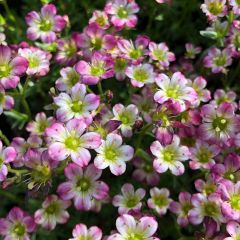
Saxifraga arendsii Pixie
- Flowering time June to September
- Height at maturity 5 cm
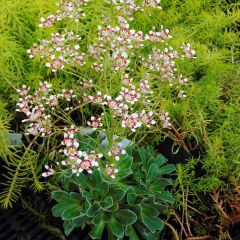
Saxifraga cotyledon Southside Seedling
- Flowering time June to August
- Height at maturity 50 cm
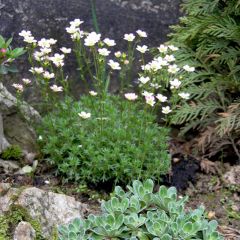
Saxifraga arendsii Adebar
- Flowering time June to September
- Height at maturity 5 cm

Saxifraga arendsii Peter Pan
- Flowering time June to September
- Height at maturity 5 cm
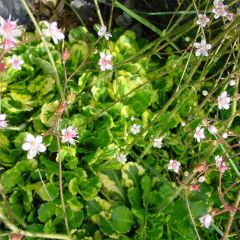
Saxifraga umbrosa Variegata
- Flowering time June, July
- Height at maturity 30 cm
These saxifrages prefer humus-bearing, light, and relatively cool soils. They tend to form tufts or carpets, with larger foliage than alpine rockery species. They mainly consist of species native to Asia (Saxifraga fortunei, stolonifera, cortusifolia…), to which we can add Saxifraga urbium and Saxifraga umbrosa, as they also appreciate shaded environments.
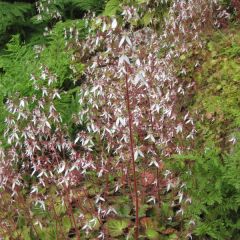
Saxifraga stolonifera Cuscutiformis
- Flowering time August, September
- Height at maturity 30 cm
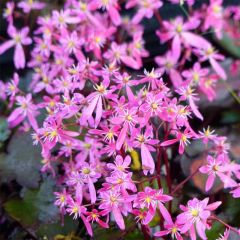
Saxifraga cortusifolia Black Ruby
- Flowering time October to December
- Height at maturity 15 cm

Saxifraga x urbium
- Flowering time June to September
- Height at maturity 25 cm

Saxifraga umbrosa Variegata
- Flowering time June, July
- Height at maturity 30 cm
Discover other Saxifraga
View all →Available in 1 sizes
Available in 1 sizes
Available in 1 sizes
Available in 1 sizes
Available in 1 sizes
Available in 0 sizes
Available in 1 sizes
Available in 1 sizes
Available in 1 sizes
Available in 1 sizes
Where, when, and how to plant saxifrages
Where to plant?
Although saxifrages are known for being rock garden plants, they comprise a diverse group, and the growing conditions will vary greatly depending on whether you choose alpine or Asian species! Alpine saxifrages require much drier, rockier, and well-draining situations than Asian species.
Alpine saxifrages thrive in rockeries, stone troughs, basins, low walls, between the slabs of a paving, in a crevice between rocks… They can fit in just about anywhere. They are also ideal for green roofs! They enjoy sunlight, but some may prefer to avoid direct sun during the hottest hours of the day. It is important that the substrate is truly draining. Don’t hesitate to add gravel or coarse sand when planting. Saxifrages are also well-suited for creating mini rockeries: for example, take a large container or a trough where you will place gravel, along with other small plants: sedum, houseleek…
Saxifrages are perfect for greening neglected spaces where other plants won’t grow! They require little substrate, tolerate poor soils, and withstand difficult conditions.
Asian saxifrages prefer shade, in rich and cool soil, yet very draining. They are perfect for undergrowth! They appreciate fresh, light substrates rich in humus. Saxifrage stolonifera can be planted as ground cover at the base of trees and bushes.
Saxifrages can be planted in pots to create a composition. Saxifrage stolonifera is ideal for hanging baskets as its stolons give it a lovely trailing habit. Asian species grown in pots should be placed in shade or partial shade, alongside heucheras, ivy, or carex… Alpine saxifrages can be planted in a basin, a very wide container, or a terracotta pot filled with draining substrate and gravel. Pair them with houseleeks and sedums, and place the pot in the sun.
When to plant?
You can plant saxifrages in spring, around April, but also in autumn.
How to plant?
The planting distance to respect varies depending on the species: between 15 cm for the smallest, and up to 40 cm for the largest.
To plant your saxifrages:
- Start by digging a planting hole, about twice the size of the root ball. You can add gravel or coarse sand to improve drainage, especially if you are growing alpine species.
- Remove the root ball from its pot, and plant it.
- Replace the soil all around, then gently firm it down.
- Water.
Continue to water in the weeks following planting.
If you are planting between stones, on a low wall, or in a crevice of rocks, slide in some potting mix mixed with a bit of sand to create a pocket of substrate, then install the plant and water gently.
You can also grow saxifrages in pots. Choose a container that is ideally flared, wide, and not very tall, made of terracotta or stone. Place gravel or broken pot pieces at the bottom, then install a well-draining substrate (a mix of potting soil, coarse sand, and gravel). Don’t hesitate to place a few small stones on the surface to create a small rockery effect.
Care
The maintenance of saxifrages is quite limited, but they do require a bit of attention. Asian species will appreciate some watering during dry spells, as well as applications of well-decomposed compost, as they prefer relatively cool and humus-bearing soils.
Once the flowering is over, it is best to cut off the faded flowers or inflorescences.
For alpine species, do not hesitate to install a mineral mulch on the surface of the medium. In addition to its ornamental interest, this recreates conditions similar to their natural habitat, prevents water from stagnating around the collar of the plant, and keeps weeds from growing.
If your saxifrages are placed under deciduous trees, remove the dead leaves in autumn to clear the rosettes and prevent them from rotting. Similarly, do not hesitate to regularly weed and prune the plants around your saxifrages, as they do not like confined environments; it is important for air to circulate!
If you live in a rainy region and are growing alpine saxifrages, we advise you to shelter them from the rain in winter. They dislike excess moisture, which could cause them to rot! You can cover them, or if you are growing them in pots, bring them under a cold frame.
Saxifrages are robust plants, not very susceptible to diseases. However, their leaves are sometimes nibbled by slugs, especially in woodland saxifrages, such as Saxifraga fortunei. Saxifrages can also be attacked by aphids and red spider mites. Be also cautious of otiorhynchs, a type of weevil whose larvae consume the roots of saxifrages (especially when the plant is grown in a pot)! In case of an attack, you can treat with nematodes (Heterorhabditis bacteriophora), which parasitise the larvae.
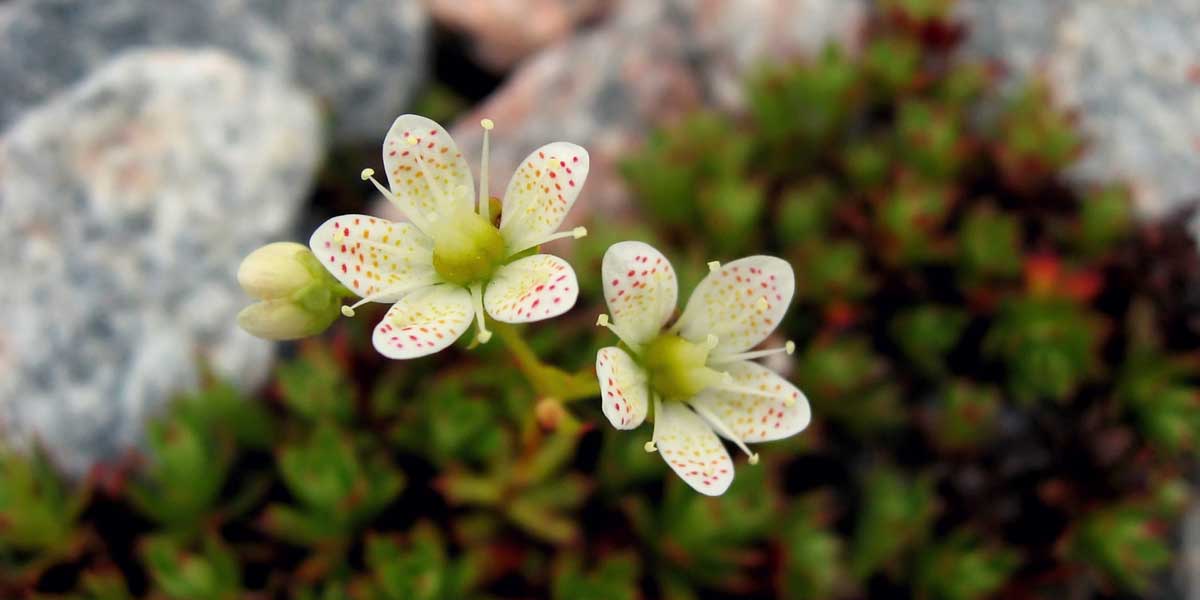
Saxifraga tricuspidata (photo Kim Hansen)
Propagation
Saxifrages are preferably multiplied by taking rosettes from the outside of the clump, or, in some species, by collecting stolons or bulblets. Multiplying saxifrages in this way, vegetatively, will allow you to preserve the varieties! These techniques are preferred over sowing.
Division of clumps
You can divide the clumps in spring, around May. Over time, saxifrages tend to become bare in the centre of the clump. Division will prevent this problem by regenerating the plants, in addition to allowing you to replant them in other locations in your garden or to give them to your friends! Saxifrages form small peripheral rosettes next to the initial rosettes: you just need to take them. You can do this approximately every three years.
- Gently dig up a sufficiently large and healthy clump, aged several years. Try to keep as many roots as possible.
- Separate it into several fragments, possibly using a knife. Make a clean and precise cut.
- Replant them immediately in a pot containing well-draining substrate (potting soil, coarse sand, gravel). Place the rosette on the substrate, pushing it in very slightly.
- Water.
- Place the pot in partial shade.
- You can plant the young plants in the garden in autumn.
Collecting stolons
Saxifraga stolonifera produces long, thin purplish-red stems that produce small seedlings at their tips. It is very easy to collect these seedlings by separating them from their mother plant. Cut the stem and replant them in a pot or at another location in your garden. The best time to divide the stolons is in spring.
Collecting bulblets
Some saxifrages, such as Saxifraga granulata, bulbifera, or cernua, produce bulblets. Simply take them and replant them in the soil.
Associating Saxifrages in the garden
Alpine saxifrages are perfect for rock gardens! They will pair beautifully with sedums, small trailing campanulas, silver baskets (Arabis caucasica), rock geraniums (such as Geranium cinereum), helianthemums, and Corsican spurge (Euphorbia myrsinites). Also, add some houseleeks, whose spiralled rosette leaves resemble those of saxifrages! Prefer plants suited to dry soils that grow in small cushions or mats. You can incorporate some ground covers like Leptinella or Acaena.
In the same spirit, saxifrages easily enhance a dry stone wall, a green roof, or any other stony location with little substrate! For example, plant saxifrages in the cracks between stones. You can combine them with wall campanulas, houseleeks, sedums, moss phlox, Cymbalaria muralis… If you want a bit more volume and colour, you can plant some red valerian (Centranthus ruber) and wallflowers (Erysimum cheiri)!
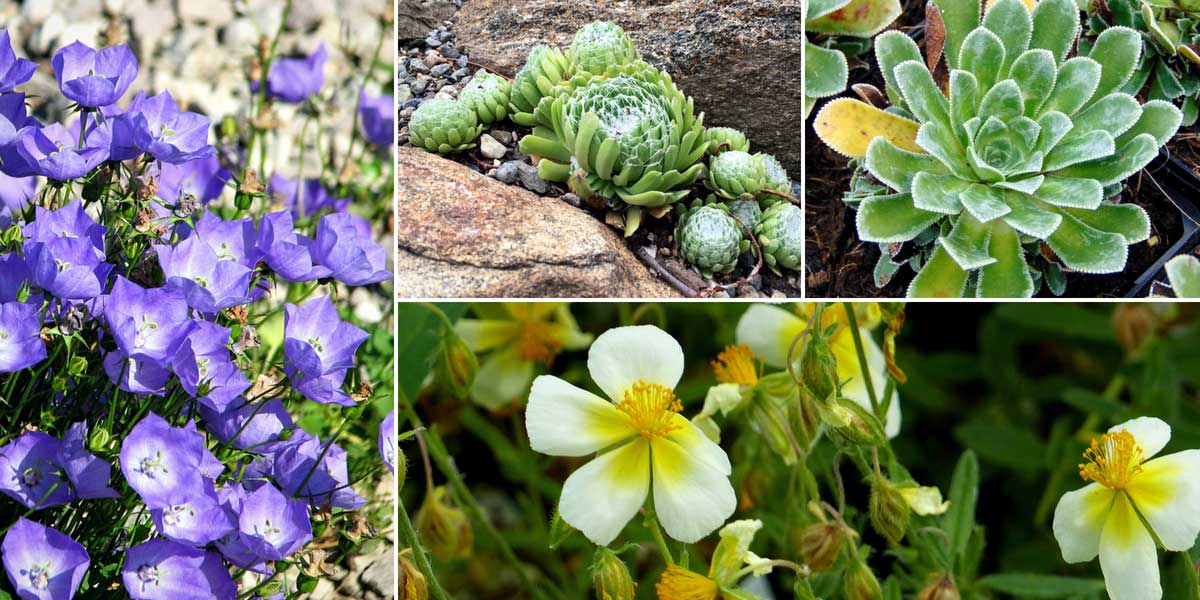
An idea for a dry garden or rockery. Campanula carpatica, Sempervivum arachnoideum (photo Kristine Paulus), Saxifraga cotyledon ‘Southside Seedling’, and Helianthemum ‘Elfenbeinglanz’
You can recreate a mini-rockery in a very large bowl or container by combining very small plants: saxifrages, sedums, houseleeks… Install stones and small decorative elements to create a kind of miniature garden.
It is also possible to use saxifrages to create an alpine plant garden or a mountain plant garden! Pair them with androsaces, Lewisia, Edelweiss, Geum montanum, houseleeks, and acaules gentians… Also, integrate some ornamental alliums, with the blue flowering of Allium cyaneum or the mauve of Allium cyathophorum!
Asian saxifrages allow for a rather natural scene in a woodland garden, for example with ferns. You can use Saxifraga stolonifera as ground cover, and plant it alongside pulmonarias, epimediums, tiarella, and tricyrtis… Also enjoy plants with decorative foliage, such as hostas, ophiopogons, and brunneras. Discover the stunning fern Coniogramme emeiensis!
You can also choose other Asian saxifrages, such as Saxifraga fortunei or Saxifraga cortusifolia… With their rather colourful flowers, fortunei saxifrages are ideal for brightening up a woodland! Their late flowering is precious for adding colour when flowers start to dwindle! They pair wonderfully with heucheras, ostrich ferns, Matteuccia, brunneras, and Persicaria filiformis…
You can also create a stunning pot composition by combining your saxifrages with the decorative foliage of heucheras. Also add ivies, muehlenbeckia, and Carex, and discover the light inflorescences of Tiarella! With its long trailing stems, which earn it the nickname “spider saxifrage”, Saxifraga stolonifera is perfect for hanging!
Did you know?
- A medicinal plant
Meadow saxifrage, particularly Saxifraga granulata, has medicinal properties. It is a diuretic, stimulates the digestive system, and is effective against kidney stones (which earns it the nickname “Gravel herb”). It is also rich in vitamin C.
Useful resources
-
- Discover our range of saxifrages!
- An article by Michael on our blog – A new saxifrage for shade with enchanting flowers
-
- To pair with saxifrages: our selection of perennials for rockeries
- Our tips for creating a green roof
- The website of the Saxifrage Society
- Subscribe!
- Contents
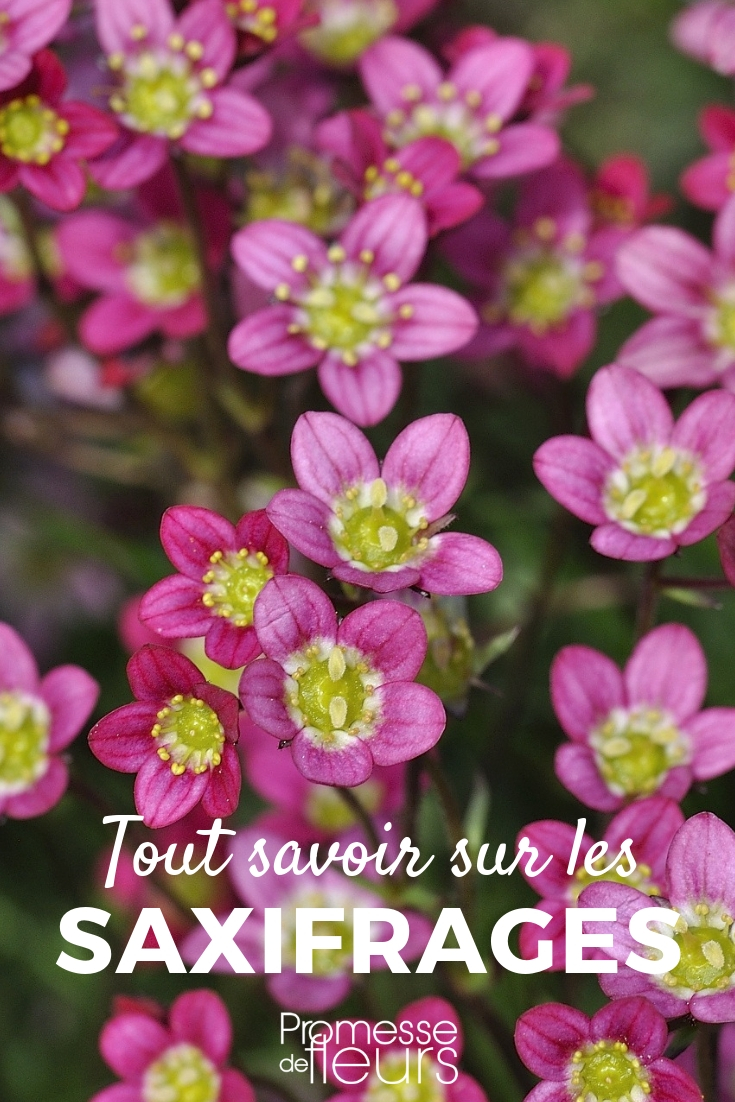































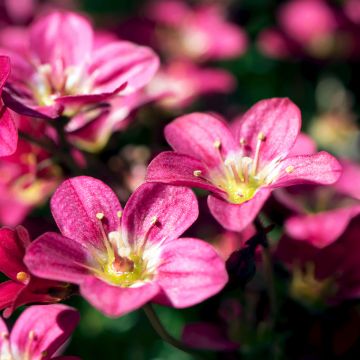
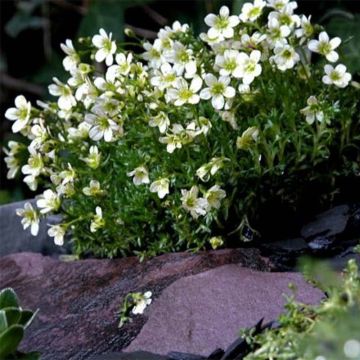
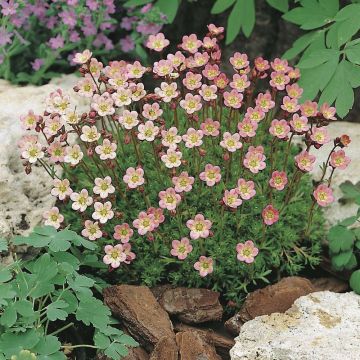
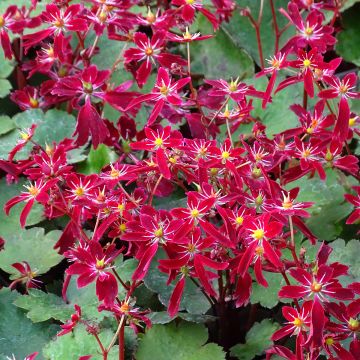
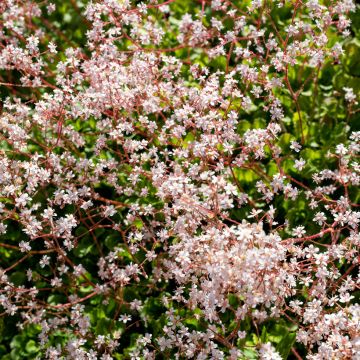
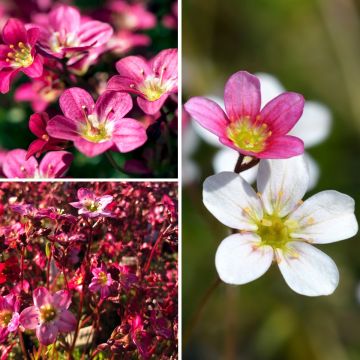



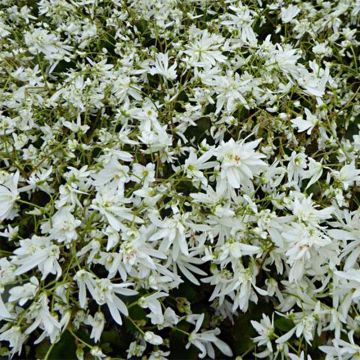
Comments